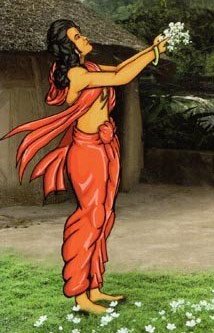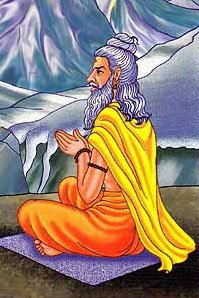Balakhilya, Bālakhilya, Bala-khilya: 8 definitions
Introduction:
Balakhilya means something in Hinduism, Sanskrit. If you want to know the exact meaning, history, etymology or English translation of this term then check out the descriptions on this page. Add your comment or reference to a book if you want to contribute to this summary article.
In Hinduism
Kavya (poetry)
Source: archive.org: The ocean of story, vol. 1Bālakhilya (बालखिल्य).—Divine personages of the size of a thumb. Sixty thousand were produced from Brahmā’s body and surrounded the chariot of the sun. The legend of Garuḍa and the Bālakhilyas is found in the Mahābhārata (see De Gubernatis, Zoological Mythology, p. 95).

Kavya (काव्य, kavya) refers to Sanskrit poetry, a popular ancient Indian tradition of literature. There have been many Sanskrit poets over the ages, hailing from ancient India and beyond. This topic includes mahakavya, or ‘epic poetry’ and natya, or ‘dramatic poetry’.
Purana and Itihasa (epic history)
Source: archive.org: Puranic EncyclopediaBālakhilya (बालखिल्य).—(VĀLAKHILYAS). A group of hermits. Origin. Sixty thousand hermits were born to Kratu, one of the Saptarṣis (seven hermits), by his wife, Santati.* They are called Bālakhilyas. Everyone of them was only the size of half a thumb, but they were as bright as the blazing sun and had attained control over their senses. (Viṣṇu Purāṇa, Aṃśa 1, Chapter 10). (See full article at Story of Bālakhilya from the Puranic encyclopaedia by Vettam Mani)
Source: archive.org: Shiva Purana - English TranslationBālakhilya (बालखिल्य) or Vālakhilya refers to a group of deities that sprang from the semen of Brahmā, according to the Śivapurāṇa 2.3.49 (“The delusion of Brahmā”).—Accordingly, as Brahmā narrated to Nārada: “[...] O dear, my semen pressed very frequently, turned into several sparkling drops. Thousands of sages called Vālakhilyas sprang up from the sparkling drops. O sage, then the sages, gathered near me with great pleasure and said—‘O father O father’. They were then sternly told by you urged by Śiva’s wish. The Vālakhilyas were rebuked angrily by you”.

The Purana (पुराण, purāṇas) refers to Sanskrit literature preserving ancient India’s vast cultural history, including historical legends, religious ceremonies, various arts and sciences. The eighteen mahapuranas total over 400,000 shlokas (metrical couplets) and date to at least several centuries BCE.
Languages of India and abroad
Sanskrit dictionary
Source: DDSA: The practical Sanskrit-English dictionaryBālakhilya (बालखिल्य).—a class of divine personages of the size of a thumb and produced from the creator's body and said to precede the sun's chariot (their number is said to be sixty thousand); cf. R.15.1; क्रतोश्च सन्ततिर्भार्या बालखिल्यानसूयत । षष्टिर्यानि सहस्राणि ऋषिणामूर्ध्व- रेतसाम् (kratośca santatirbhāryā bālakhilyānasūyata | ṣaṣṭiryāni sahasrāṇi ṛṣiṇāmūrdhva- retasām) || Mārk. P.
Derivable forms: bālakhilyaḥ (बालखिल्यः).
Bālakhilya is a Sanskrit compound consisting of the terms bāla and khilya (खिल्य).
Source: Cologne Digital Sanskrit Dictionaries: Shabda-Sagara Sanskrit-English DictionaryBālakhilya (बालखिल्य) or Bālikhilya.—m.
(-lyaḥ) A divine personage, of the size of the thumb, sixty thousand of whom were produced from the hair of Brah- Ma'S body.
Source: Cologne Digital Sanskrit Dictionaries: Benfey Sanskrit-English DictionaryBālakhilya (बालखिल्य).—[bāla-khilya] (ved.), m. A divine personage of the size of the thumb, sixty thousand of whom were produced from the hair of Brahman's body, Mahābhārata 13, 442; [Sundopasundopākhyāna] 3, 5.
Source: Cologne Digital Sanskrit Dictionaries: Monier-Williams Sanskrit-English DictionaryBālakhilya (बालखिल्य):—[=bāla-khilya] [from bāla] See vāla-kh.
Source: Cologne Digital Sanskrit Dictionaries: Yates Sanskrit-English DictionaryBālakhilya (बालखिल्य):—(lyaḥ) 1. m. A divine personage of the size of the thumb.
Sanskrit, also spelled संस्कृतम् (saṃskṛtam), is an ancient language of India commonly seen as the grandmother of the Indo-European language family (even English!). Closely allied with Prakrit and Pali, Sanskrit is more exhaustive in both grammar and terms and has the most extensive collection of literature in the world, greatly surpassing its sister-languages Greek and Latin.
See also (Relevant definitions)
Partial matches: Khilya, Bala.
Starts with: Balakhilyagrantha, Balakhilyasamhita, Balakhilyashastra.
Ends with: Haundinabalakhilya.
Full-text: Valakhilyas, Balayani, Valakhilya, Balikhilya, Sannati, Kratu, Bali, Abhisheka.
Relevant text
Search found 15 books and stories containing Balakhilya, Bālakhilya, Bala-khilya, Bāla-khilya; (plurals include: Balakhilyas, Bālakhilyas, khilyas). You can also click to the full overview containing English textual excerpts. Below are direct links for the most relevant articles:
Puranic encyclopaedia (by Vettam Mani)
The Markandeya Purana (by Frederick Eden Pargiter)
Historical Elements in the Matsya Purana (by Chaitali Kadia)
Lineages of Vasiṣṭha < [Chapter 6 - Human history in the Matsya-Purāṇa]
The Skanda Purana (by G. V. Tagare)
Chapter 16 - Greatness of Maṇikarṇikeśvara (Maṇikarṇika-īśvara) < [Section 3 - Arbuda-khaṇḍa]
Sri Krishna-Chaitanya (by Nisikanta Sanyal)
Chapter 6 - History of Theism < [Volume I - Introductory]
The Vishnu Purana (by Horace Hayman Wilson)